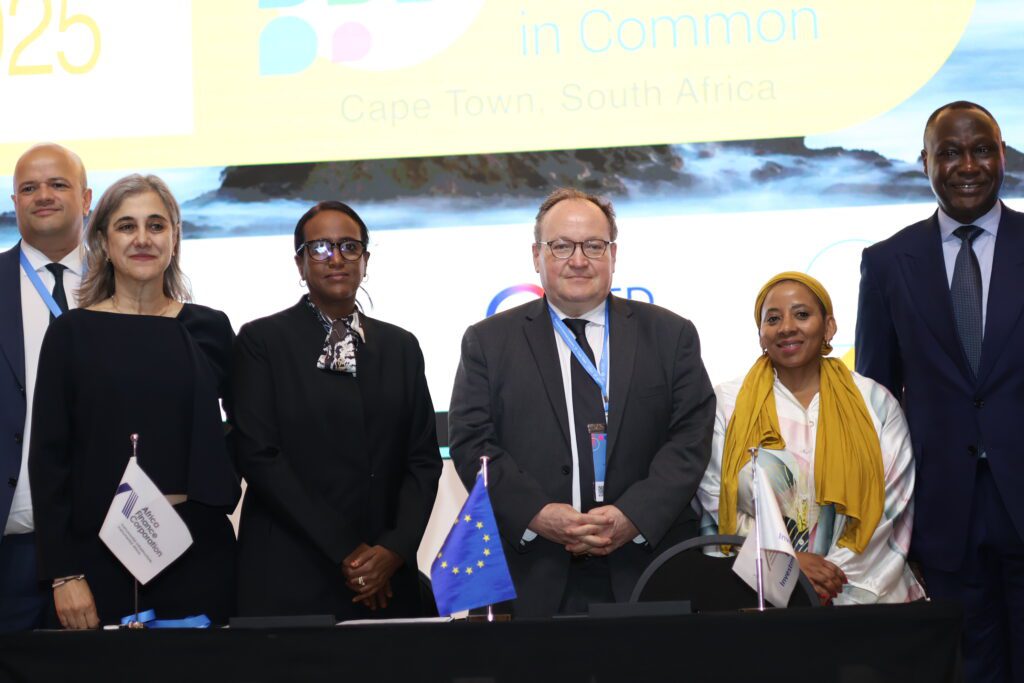
Thursday, February 27, 2025

By inAfrika Reporter
CAPE TOWN, South Africa, The European Investment Bank (EIB) has committed to financing the $750 million Infrastructure Climate Resilient Fund (ICRF) in collaboration with the Africa Finance Corporation (AFC). This initiative aims to accelerate climate adaptation and sustainable infrastructure development across Africa, ensuring long-term economic resilience.
EIB confirmed an investment of $52.48 million in the Fund, managed by AFC Capital Partners (ACP). This follows a $253 million commitment from the Green Climate Fund (GCF), marking its largest-ever equity investment in Africa. Additional contributions from the Nigeria Sovereign Investment Authority (NSIA) and private African pension funds reinforce institutional confidence in the Fund’s mission.
The ICRF integrates climate resilience into infrastructure projects, embedding risk mitigation from design to operation. By leveraging blended finance, the Fund attracts private investment while employing innovative mechanisms such as climate risk parametric insurance to safeguard assets against environmental challenges. Additionally, it will provide technical support to nations developing climate risk assessments and adaptation plans, aligning with global sustainability goals.
The agreement was formalized at the Finance in Common Summit (FICS) in Cape Town, underscoring the EIB’s commitment to strengthening Africa’s infrastructure. Ambroise Fayolle, EIB Vice-President, emphasized the significance of this partnership: “Supporting private sector investment in climate-resilient infrastructure is crucial for regions most vulnerable to climate change. This Fund will catalyze further investment, reduce risks, and showcase best practices in sustainable finance.”
AFC’s President & CEO, Samaila Zubairu, highlighted the Fund’s importance in bridging Africa’s climate adaptation financing gap: “This initiative secures economic stability while creating opportunities for sustainable growth. Partnering with EIB and other investors ensures we expand the reach and impact of climate finance.”
The ICRF focuses on strengthening Africa’s ability to withstand climate risks by prioritizing investments in transport, clean energy, digital infrastructure, and industrial development. ACP’s strategy assesses climate risks comprehensively, ensuring projects align with sustainability benchmarks. This initiative is set to mobilize up to $3.7 billion in additional financing, driving large-scale deployment of climate-resilient infrastructure across the continent.
The Fund will target 10 to 12 projects across Africa, facilitating capacity-building efforts to enhance climate risk adaptation. With support from the GCF, it will also cover first-loss tranches to attract further private capital. Key projects in the pipeline include the Lobito Corridor, a major trade and logistics route linking Angola, the Democratic Republic of Congo, and Zambia. This corridor is expected to transform regional connectivity by enabling efficient transportation of minerals, agricultural goods, and other commodities.
Through strategic collaboration, the ICRF advances Africa’s green transition while supporting economic growth. With a strong institutional framework and a focus on environmental sustainability, this Fund represents a critical step in ensuring Africa’s infrastructure remains resilient amid evolving climate challenges.



Evans Rubara says:
This is great news! However, when analyzing the European Investment Bank (EIB) and Africa Finance Corporation (AFC) $750M Fund for Climate Infrastructure from a critical perspective, several key questions can help clarify the roles of implementers and beneficiaries.
Firstly, regarding the implementers, it is essential to identify the primary stakeholders involved in the fund’s execution. Understanding which organizations or entities are directly responsible for implementing the fund will provide insight into the project’s management. Additionally, the criteria used to select these implementers are crucial. Are there specific qualifications or standards that organizations must meet to be considered for fund management? This inquiry can reveal the level of expertise and accountability expected from those involved.
Moreover, exploring the governance structures in place to oversee the implementation of funded projects is important. What governance frameworks ensure transparency and accountability? Furthermore, understanding the decision-making processes regarding project selection and fund allocation can shed light on how priorities are established. It is also pertinent to examine the partnerships formed, including collaborations with local governments, NGOs, or private sector entities, as these relationships can influence project outcomes.
On the beneficiaries’ side, identifying who the intended beneficiaries are is vital. Which communities, sectors, or groups are targeted to benefit from the fund? Additionally, understanding how beneficiary needs are assessed is crucial. What methodologies are used to identify and prioritize these needs? Equitable distribution of benefits is another significant consideration. What measures are in place to ensure that marginalized or underserved communities receive their fair share of benefits from the fund?
Furthermore, it is essential to clarify the expected outcomes for beneficiaries. What specific improvements or changes should they anticipate from the funded projects? Involving beneficiaries in the planning and implementation processes is also critical. What role do they play in shaping projects that affect their lives?
Lastly, sustainability and long-term impact should be central to the discussion. How will the projects funded by this initiative ensure lasting benefits for both the environment and the communities involved? Monitoring and evaluation systems are also crucial for measuring effectiveness and impact. What mechanisms are in place to track progress and outcomes? Additionally, understanding the potential risks associated with the fund and how they will be mitigated is essential to protect the interests of beneficiaries.